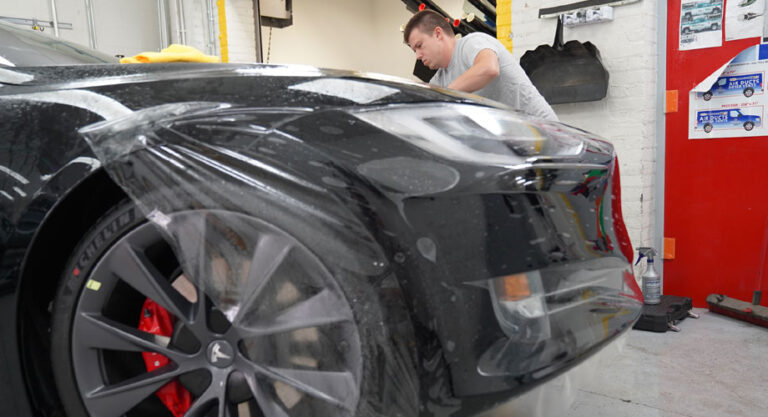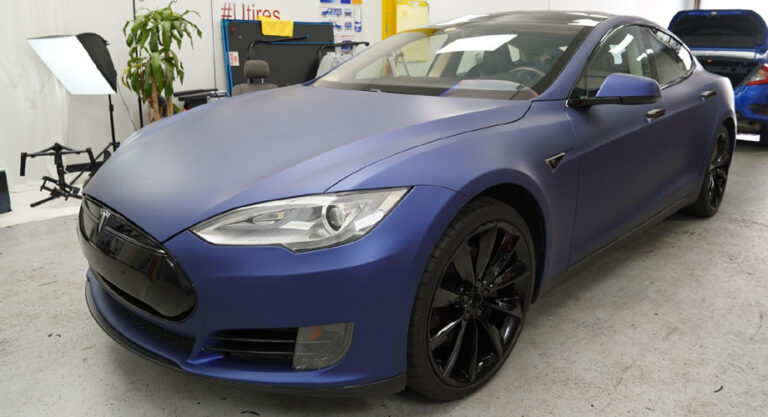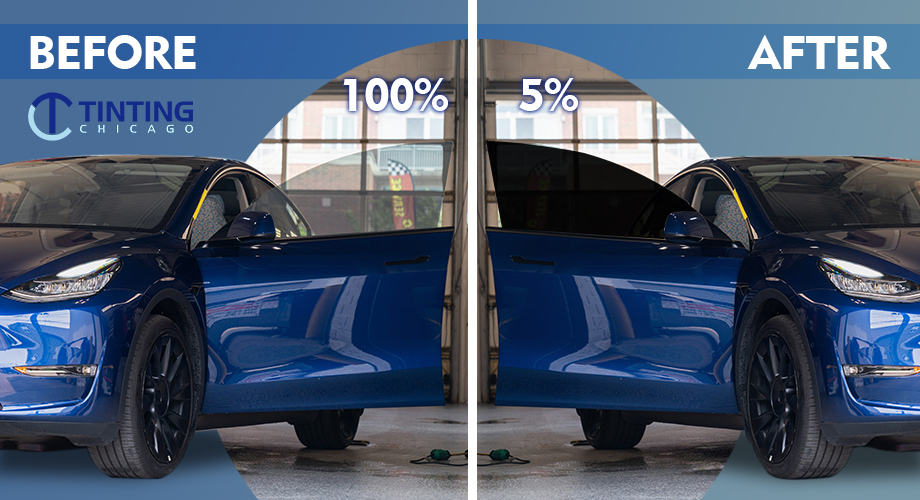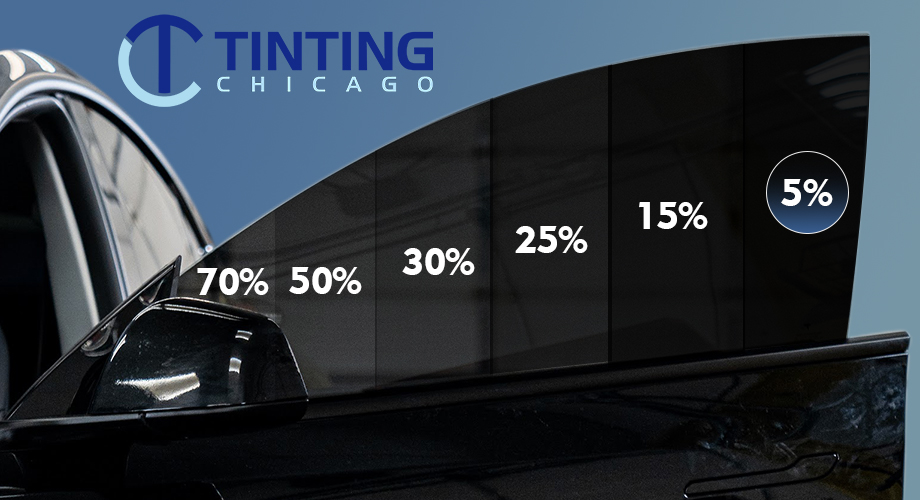





















































































































































































































Window tinting in cars is one of the ways to add character to your vehicle, make the driving experience more comfortable, and increase the security of the items you leave in the car.
Today, we’re going to look at one of the darkest options, namely 5% tint on windows, the advantages, and disadvantages of such tinting, and the practical aspects of this issue.

Benefits of Car 5% Tinting
5% tint on all windows gives your car a premium style. 5% means that the tint blocks about 95% of the light that could potentially penetrate the interior.
As for the practical aspects of using such films, they are as follows:
- Increased privacy and security. You get rid of the feeling that you are being watched, as it is almost impossible to see who or what is in the cabin from the outside.
- UV protection for passengers. The tint film serves as a blocker of harmful ultraviolet rays that affect the health and well-being of passengers and the driver.
- Heat reduction inside the car. Because less sunlight penetrates the interior, surfaces, especially the dashboard or leather decorative elements, and seats heat up less.
- Protection of car interior from fading. Some interior elements of the car interior are prone to fading under prolonged exposure to sunlight, which is why an additional tint film protects against it.
However, don’t forget that you should first check whether your car is eligible for 5% tinting (in particular, according to state regulations) and choose the appropriate type of glass coating.
Types of Window 5% Tints
5% tint on side windows can be applied in several ways, for example:
- Dyed window tint. A special transparent paint creates a shaded layer that transmits less light.
- Metalized window tint. A powder material coats the glass and creates a metallized layer with a mirror effect.
- Carbon window tint. A special film with a partially transparent fiber that shades the glass.
- Ceramic window tint. A durable thin film saturated with pigment for glass tinting.
Please note that not only car windows can be tinted, but also headlights, dimensions, side mirrors. In particular, on such vehicles as:
In addition, tinting is also widespread in the real estate segment. For example, to shade office or even residential premises, to create a suitable exterior appearance, etc.
Legal Regulations on 5% Car Tinting
Depending on the state, there may be restrictions on the maximum percentage of tint that can be applied to vehicles.
You should not use a film darker than 35% on a car designed to carry passengers in Illinois, for example:
To be more precise, you can even use 5% tint on back windows, but the restrictions for the front glass are in the range of 35-50%. By the way, mirror films are generally prohibited by law here.
DIY vs. Professional Tinting
It is true that you can buy a 5% window tint kit and glue the glass in your car yourself. However, is the time, effort, and result worth it? Let’s find out.
Pros And Cons of DIY Tinting Kits
There is really only one advantage – the cost of gluing the film. Yes, you don’t pay for the work; you save on the material. Instead, you can glue the film incorrectly, leave dirt, air bubbles, not cover part of the surface, etc.
Benefits of Professional Tinting Services
If you entrust the work to experts, such as the Tinting Chicago team, you will get a high-quality result that will look good for several years. Of course, you will pay for the work, but if you want to save money, you can choose a cheaper film or just gradually tint your car.
our latest news!
Factors to Consider Before Tinting
Even though you cannot use 5% tint on all windshield, you need to prepare for tinting the rest of the windows:
- Choosing the right tint percentage. Given that vehicles such as SUVs may already have partial tinting (e.g., the rear door glass), you need to select the right tint for the remaining areas.
- Understand the tinting laws in your area. It is worthwhile to thoroughly study the permitted tinting limits to avoid getting a fine when you are stopped and checked.
- Selecting a reputable tinting service provider. Although the tinting process does not look difficult, even the visibility through the film from the interior depends on its quality. Therefore, it is better to trust the work of a pro like Tinting Chicago.
Failure to take these factors into account can lead to problems with the police, poor visibility, or rapid wear of the film.
Tinting Process
It is clear that, for example, applying 5% tint on house windows does not cause issues. However, car windows are somewhat different in design, so it takes a little more effort to tint them:
- Preparing the car for tinting. First, you need to clean the glass and remove the film (if it is already present). In some cases, the glass from the doors is removed first.
- Application of the tint film. The glass surface is wetted, and then the tint film is glued to it.
- Curing and drying process. When the film is applied, air bubbles are formed, which are expelled with a scraper, and the material itself is adjusted to the shape and contours of the glass, the lower part is driven under the card.
Does it look simple? However, in practice, problems can arise during the second stage, so it is better to trust this process with professionals.
Common Misconceptions About Tinting
5% tint on all windows is a death sentence for drivers, as they cannot see anything from the cabin, especially at night or in a tunnel under a bridge. Have you heard this opinion? Well, let’s debunk the myths.
Myth Debunking: Tinted Windows Reduce Visibility
They don’t, if you use a high-quality and correct film. For example, such manufacturers as XPEL, RAYNO, Suntek, 3M, LLumar. In fact, the films have a double structure that blocks the light only from the outside, but is almost completely transparent from the inside.
Addressing Concerns About Tint Peeling or Bubbling
Nothing lasts forever, but tint films (if installed by a professional) can last at least five years without any issues or defects.
Summary
With a 5% tint on your car windows, your vehicle will gain not only aesthetic but also practical benefits. For example, the interior will heat up less even in the heat, its decorative elements will not fade as quickly, and passers-by will not see what is happening in the car.
However, you shouldn’t waste your time and nerve cells trying to “save money” on tinting. Entrust this process to Tinting Chicago professionals and get a high-quality result that will delight you for years!
FAQ
What is 5% tinting for cars?
This is the darkest legal tint for cars, cutting off about 95% of the light that would otherwise enter the interior. However, this tint is not allowed everywhere.
Is 5% tinting legal for cars?
In most cases, such tinting is allowed on the rear side windows. However, in some states, even for them, the peak threshold is 35%.
What are the benefits of 5% tinting for cars?
Since the film not only restrains light but also partially absorbs heat, the car interior heats up less. Plastic, decorative elements, and textiles on the seats also fade less.






























 Send a message
Send a message Send a message
Send a message
